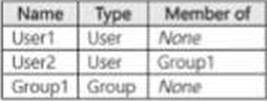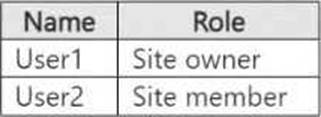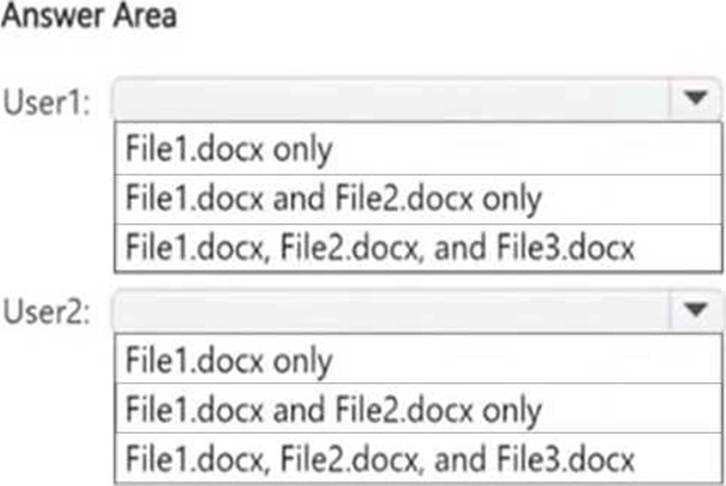Practice Free SC-401 Exam Online Questions
Note: This question is part of a series of questions that present the same scenario. Each question in the series contains a unique solution that might meet the stated goals. Some question sets might have more than one correct solution, while others might not have a correct solution.
After you answer a question in this section, you will NOT be able to return to it. As a result, these questions will not appear in the review screen.
You have a Microsoft 365 tenant and 500 computers that run Windows 11. The computers are onboarded to Microsoft Purview.
You discover that a third-party application named Tailspin_scanner.exe accessed protected sensitive information on multiple computers. Tailspin_scanner.exe is installed locally on the computers.
You need to block Tailspin_scanner.exe from accessing sensitive documents without preventing the application from accessing other documents.
Solution: From Microsoft Defender for Cloud Apps, you create an app discovery policy.
Does this meet the goal?
- A . Yes
- B . No
B
Explanation:
Creating an app discovery policy in Microsoft Defender for Cloud Apps is used for detecting and monitoring cloud application usage, but it does not prevent a locally installed application (Tailspin_scanner.exe) from accessing sensitive files on Windows 11 devices.
To block Tailspin_scanner.exe from accessing sensitive documents while allowing it to access other files, the correct solution is to use Microsoft Purview Endpoint Data Loss Prevention (Endpoint DLP) and add Tailspin_scanner.exe to the Restricted Apps list.
Endpoint DLP allows you to block specific applications from accessing sensitive files while keeping general access available. Restricted Apps List in Endpoint DLP ensures that Tailspin_scanner.exe cannot open, copy, or process protected documents, but it can still function normally for non-sensitive content.
You are creating a data loss prevention (DLP) policy that will apply to all available locations except Fabric and Power BI workspaces.
You configure an advanced DLP rule in the policy.
Which type of condition can you use in the rule?
- A . Sensitive info type
- B . Content search query
- C . Sensitive label
- D . Keywords
A
Explanation:
When configuring an advanced DLP rule in Microsoft Purview Data Loss Prevention (DLP), you can use a Sensitive Information Type (SIT) condition to detect and classify specific types of sensitive data, such as credit card numbers, Social Security numbers, or custom sensitive data patterns. This allows you to apply protection and trigger actions based on the identified content.
You have a Microsoft 565 subscription that contains 100 users and a Microsoft 365 group named Group1. All users have Windows 11 devices and use Microsoft SharePoint Online and Exchange Online. A sensitivity label named Label! is published as the default label for Group1. You add two sublabels named Sublabel1 and Sublabel2 lo Label1. You need to ensure that the settings in Sublabel 1 are applied by default to Group 1.
What should you do?
- A . Change the order of Sublabel!
- B . Duplicate all the settings from Sublabel! to Label1.
- C . Modify the policy of Label1.
- D . Delete the policy of Label1 and publish Sublabel1.
HOTSPOT
You have a Microsoft 365 IS subscription that contains the resources shown in the following table.

The subscription contains a Windows 11 device named Device 1 and has the Microsoft Purview Information Protection client installed.
Device i contains the resources shown in the following table.

You publish a sensitivity label named Label1 to User1 and Group1.
For each of the following statements, select Yes if the statement is true. Otherwise, select No.


HOTSPOT
You have a Microsoft 365 IS subscription that contains the resources shown in the following table.

The subscription contains a Windows 11 device named Device 1 and has the Microsoft Purview Information Protection client installed.
Device i contains the resources shown in the following table.

You publish a sensitivity label named Label1 to User1 and Group1.
For each of the following statements, select Yes if the statement is true. Otherwise, select No.


HOTSPOT
You have a Microsoft 36S subscription that contains the users shown in the following table.

You create the data loss prevention (DLP) policies shown in the following table.

For each of the following statements, select Yes if the statement is true. Otherwise, select No. NOTE: Each correct selection is worth one point.


HOTSPOT
You have a Microsoft 365 E5 subscription.
The subscription contains devices that are onboarded to Microsoft Purview and configured as shown in the following table.

The subscription contains the users shown in the following table.

You need to review the activities.
What should you use for each user? To answer, select the appropriate options in the answer area. NOTE: Each correct selection is worth one point.


Explanation:
User1: Since the Microsoft Purview browser extension is installed on Device1, AI-related activity performed by User1 (generating an image using a generative AI website) can be reviewed in Activity explorer in DSPM for AI.
User2: Since Device2 does not have the Microsoft Purview browser extension installed, AI-related activity cannot be tracked in DSPM for AI. Instead, Audit log search should be used to review activity
such as using Microsoft 365 Copilot.
User3: Since Device3 has the Microsoft Purview browser extension installed, AI-related activity (browsing sample content on a generative AI website) can be reviewed using Activity explorer in DSPM for AI.
You have a Microsoft 36S E5 subscription that has a Microsoft Purview exact data match (EDM) classifier named EDM1.
You plan to create the Microsoft Purview policies shown in the following table.

Which policies can use EDM1?
- A . DLP1 only
- B . Retention 1 only
- C . DLP1 and Insider1 only
- D . Insider1 and Retention1 only
- E . DLP1. Insider1, and Retention1
HOTSPOT
You have a Microsoft SharePoint Online site that contains the following files.

Users are assigned roles for the site as shown in the following table.

Which files can User1 and User2 open? To answer, select the appropriate options in the answer area. NOTE: Each correct selection is worth one point.


You have a Microsoft 365 E5 subscription that contains the users shown in the following table.

Which users will Microsoft Purview insider risk management flag as potential high-impact users?
- A . User1 and User2 only
- B . User2 and User3 only
- C . User1, User2, and User3 only
- D . User1, User2, User3, and User4
D
Explanation:
Microsoft Purview Insider Risk Management flags high-impact users based on various risk factors, including role, access to confidential data, and influence within an organization.
Let’s analyze each user:
User1 (Regional Manager, assigned Reader role, manages department managers)
Risk Factors:
● Holds a managerial position (regional manager).
● Manages multiple department managers, indicating organizational influence.
● Access to critical business information.
Flagged? -Yes (Managerial role and access to confidential data).
User2 (HR department manager, no Microsoft Entra roles, manages HR department users)
Risk Factors:
● Manages HR department users, meaning they likely handle sensitive employee data.
● HR roles are often considered high-risk due to access to personal and payroll data.
Flagged? -Yes (HR role and access to sensitive employee data).
User3 (Developer, reports to User2, only user in compliance, assigned Compliance Administrator role)
Risk Factors:
● Compliance Administrator role grants access to sensitive security and regulatory data.
● Only person in the compliance department, meaning they hold a critical role.
● Potentially high impact on compliance and security settings.
Flagged? -Yes (Privileged Compliance Administrator role).
User4 (Assistant to User1, no Entra roles, handles confidential data on behalf of User1)
Risk Factors:
● Handles a high volume of confidential data on behalf of a regional manager.
● Assistants with access to sensitive data are considered insider risk candidates.
Flagged? -Yes (High access to sensitive information).
Since all four users fit high-impact criteria (managerial roles, privileged compliance access, handling sensitive data), Microsoft Purview Insider Risk Management will flag all of them.
